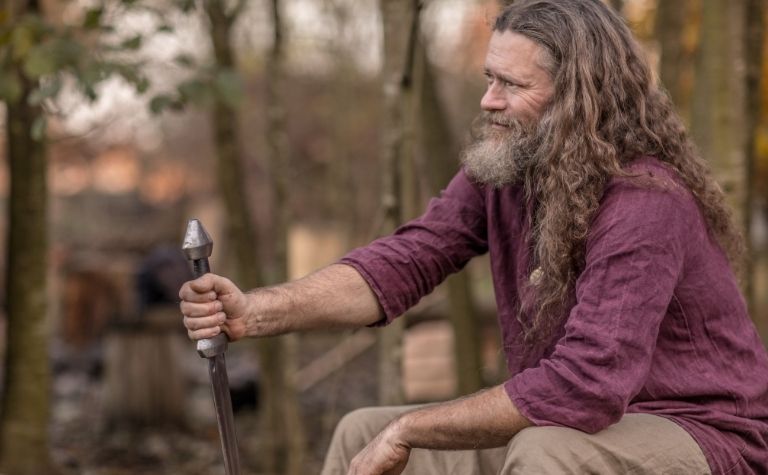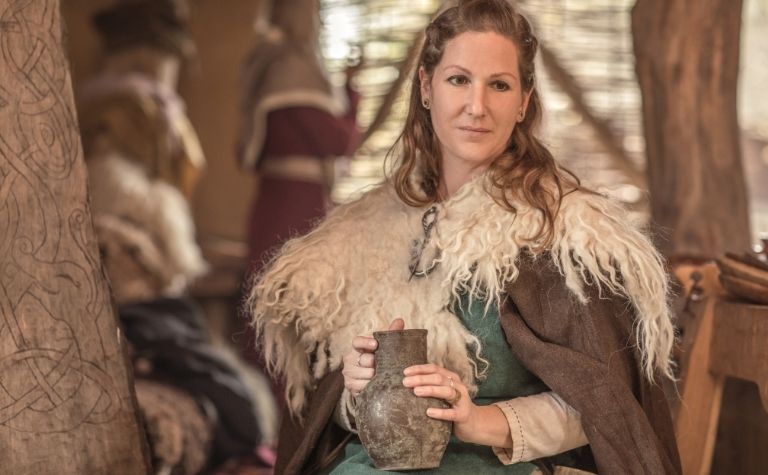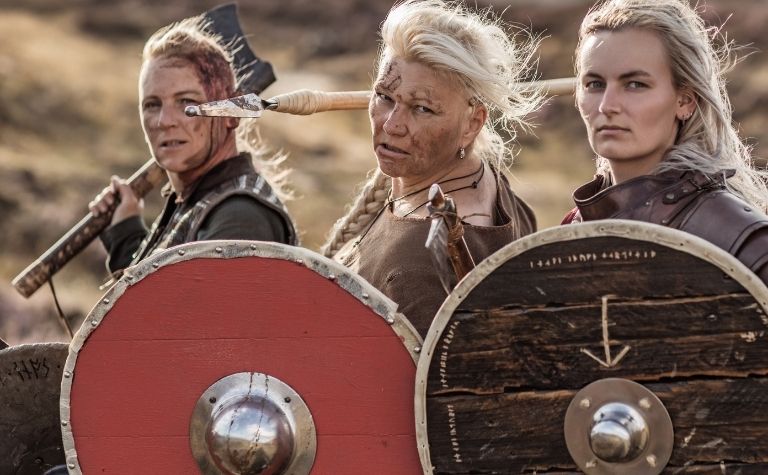When someone imagines a Viking, the first image that comes to mind for many people is a tall, muscular Scandinavian man with long hair and perhaps a beard.
The hair may be blonde, brown, or red. It may also be in braids. Is this common depiction correct? Is it fact or fiction that the Vikings had long hair?
Some Vikings did have long hair, yet multiple historical sources reveal that the most common hairstyle for men was not what most people imagined.
The fact is, many Viking men had long hair in the front of their head and wore their hair very short in the back of their head.
Nearly a millennium after their demise, people remain fascinated with the Vikings. However, sometimes it can be challenging to separate fact from fiction.
Thankfully, history sheds light on what the Vikings were like, including their daily lives.
One aspect of their daily lives was the choices they made with regard to their appearance and how they wore their hair.
Keep reading to learn more.
Are you curious about what the Vikings looked like? See What Did the Vikings Look Like? to learn what scientists believe about their faces, hairstyles, clothing, skin color, and more.

What Did the Vikings Look Like?
From television shows to movies to other art forms, popular culture has portrayed Vikings in stereotypical and inaccurate ways. (Also see Were There Any Black Vikings?)
While there may be a kernel of truth in some stereotypes regarding the appearance of Vikings, it is important to look at the most reliable evidence to determine the facts.
Fortunately, with the help of advanced technology, scientists have uncovered many facts about what the Vikings looked like.
Dreadlocks are found among different cultures of the ancient world. See Did the Vikings Wear Dreadlocks? to learn more.
Long hair in the front, short in the back
The image people often imagine when thinking of a Viking warrior is long blonde, brown, or red hair as well as with a long beard or mustache—all of which is wild and unkempt.
It may come as a surprise to some that long hair wasn’t the main hairstyle that Viking men wore.
The historical evidence suggests that Vikings wore their hair long in the front and short in the back, as a kind of reverse mullet. (Also see What Hairstyles Did the Vikings Have?)
For instance, an English letter, dated to the Middle Ages from an anonymous author, described the Danish hairstyle as blinding the eyes and shaved in the back near the neck.
This suggests that men wore their hair in the front as a long fringe or perhaps had long hair only at the top of their head that fell down in front of their face.
How did the Vikings wear their facial hair? The evidence also suggests that Viking men preferred to grow their facial hair long.
Many men wore beards and mustaches and the preference for many was not to keep them short and tidy. (Also see Were the Vikings Tall?)
Since facial hair represents masculinity in some cultures, wild and unkempt facial hair may have symbolized manhood among some Vikings.
A small carved relic that was found at a ship burial in Norway shows the whittled man wearing a long mustache and beard.
The Vikings had different hairstyles. See Did the Vikings Wear Braids? to learn more.

Viking Women Wore Their Hair Long
One common conception of how Viking women looked is that they had long blonde hair, often with pictured braids at the top of the head. This stereotype probably reveals a lot of truth. (Also see 15 Facts About Viking Women)
A small bronze relic that Scandinavian archaeologists uncovered shows a Viking woman with long hair tied at the nape of her neck.
As opposed to the men, the evidence suggests that Viking women kept their long hair well-groomed.
Since they kept their long hair relatively clean and tame, they managed it better and formed it into various styles.
What is the nature of the evidence?
There are two main ways that researchers have been able to paint an accurate picture of what the Vikings looked like, including their hairstyles: archaeological evidence and written sources.
Archaeological Evidence
According to the National Museum of Denmark, there have been over 500 Viking skeletons have been found. [1]
These skeletons tell a story and provide hints about what the Vikings looked like. (Also see Did Vikings Have Piercings?)
These skeletons allow experts to analyze bone structure, DNA, and any scratches or markings on the skeletons.
As stated previously in this article, skeletons have been able to reveal facts about hair type and grooming rituals.
Ancient Scandinavian art is also a source of archaeological evidence.
Examples include drawings or tapestries and often paint a very vivid picture of the subject researchers are studying.
What did the Vikings look like? Part of the answer to that questions concerns what kind of clothes they wore. See The Viking Dress Code: What They Wore and How to learn more.

Written Sources
Written sources are one of the most reliable sources to learn about Viking history, including their appearance and hairstyle.
A lot of what historians know of the Vikings today is from written sources ranging from old English letters and chronicles to writings of Arab ambassadors, all of which date to the time period of the Vikings.
Records of royal names also hint at the way the Vikings wore their hair. Two specific names, for example, are Fairhair and Forkbeard.
This reveals, in part, both how Vikings wore their hair and how they valued the reputation of their physical appearance.
Vikings Were Well-Groomed
One of the biggest myths of the appearance of Vikings was that they were unkempt and dirty with their hair a matted mess, and their clothing unclean and disheveled.
Louise Kæmpe Henriksen, who is a curator at the Viking Ship Museum, says otherwise. [2]
Archaeological findings have revealed that Vikings kept items that were important to grooming rituals. [3]
Hair picks, toothpicks, tweezers, and ear picks were common items that have been found in boxes, which means that these items were obviously of some importance to the people of the Viking age.
Additionally, scratch marks have been found on the teeth of Viking skeletons that also suggest the common use of toothpicks.
Written reports from medieval England also describe how Viking men were usually well-groomed and popular with the ladies.
Sources say that Viking men bathe every Saturday, contributing to their pleasant smell. They brushed their hair daily, changed their clothes frequently, and dressed respectively.
What color of hair did Vikings have? See Did the Vikings Have Blonde Hair? to learn more.
Vikings Commonly Had Either Red or Blonde Hair
With genetic research technology, scientists have discovered what color of hair was most dominant in the Viking Age.
In Denmark, Western Scandinavia, the data shows that red hair was common. However, in Northern Scandinavia (in the Stockholm area), data reveals that blonde hair was more common.
Although red and blonde hair were the most common, dark hair was also normal to have for a Viking. (Also see Did the Vikings Have Tattoos?)
Viking Men and Women Had a Similar Face Shape
Another stereotype is that women looked more masculine in the Viking Age, and evidence suggests this may be true.
Anthropologist Lise Lock Harvig has discovered that it is often hard to tell Viking men and women apart from studying their skeletons.
The women had more masculine faces than they do today, having more pronounced eyebrows and jawbones.
Although this distinction between men and women in the Viking age is common, not all skeletons are the same in this way. (Also see How Did Vikings Propose and Get Married?)
Technology paints a more accurate picture of Vikings
Fortunately, today’s technology has given scientists the opportunity to study who the Vikings were and what they looked like.
Despite some myths of all Vikings having long, tangled hair, evidence shows that the Vikings were well-groomed.
- Men commonly wore their hair long in the front and shaved short in the back.
- Women kept their hair long and groomed, able to tie it back or style it in attractive hairstyles.
Against common misconceptions, the Vikings valued healthy grooming practices, attractive make-up, and stylish hair.
There was a variety of animals, fish, and birds in Scandinavia. See What Did the Vikings Eat? to learn more.
References:
[1] Source
[2] Source
[3] Source
Also see:
